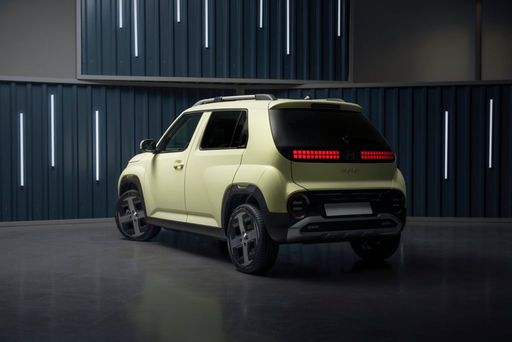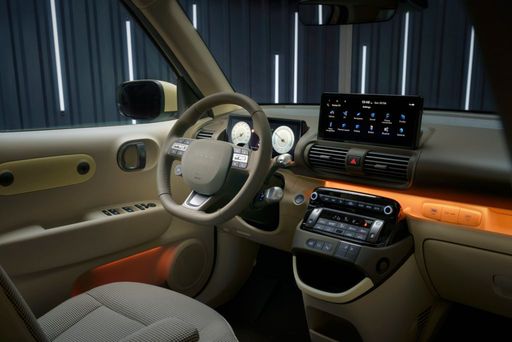Hyundai Inster vs Nissan Micra – Różnice i ceny w porównaniu
Koszty i zużycie
Porównanie ceny i zużycia paliwa często pokazuje największe różnice. Tu decyduje się, który model lepiej pasuje do budżetu.
Hyundai Inster ma nieco przewagę cenową – jego cena zaczyna się od 105000 zł, podczas gdy Nissan Micra kosztuje 123000 zł. Różnica wynosi około 17967 zł.
Pod względem zużycia energii przewagę ma Nissan Micra: z wynikiem 14.20 kWh na 100 km jest minimalny bardziej wydajny niż Hyundai Inster, który zużywa 14.30 kWh. Różnica to około 0.10 kWh.
Pod względem zasięgu Nissan Micra wypada trochę lepiej: osiąga do 416 km, czyli około 46 km więcej niż Hyundai Inster.
Silnik i osiągi
Pod maską widać, który model jest bardziej sportowy i kto ma lepszy start.
Pod względem mocy silnika Nissan Micra ma czytelny przewagę – 150 KM zamiast 115 KM. To różnica około 35 KM KM.
W przyspieszeniu 0–100 km/h Nissan Micra jest czytelny szybszy – 8 s wobec 10.60 s. Różnica wynosi około 2.60 s sekundy.
Pod względem prędkości maksymalnej jest lepszy – osiąga , podczas gdy kończy na . Różnica to około .
Różnica widoczna jest również w momencie obrotowym: Nissan Micra ciągnie czytelny mocniej – 245 Nm wobec 147 Nm. Różnica to około 98 Nm.
Przestrzeń i praktyczność
Samochód rodzinny czy codzienny towarzysz – który oferuje więcej miejsca, komfortu i elastyczności?
Miejsca siedzące: Nissan Micra oferuje lekko więcej miejsc – 5 vs 4.
Pod względem masy własnej Hyundai Inster jest niewielki lżejszy – 1380 kg wobec 1452 kg. Różnica to około 72 kg kg.
Pod względem pojemności bagażnika Nissan Micra oferuje trochę więcej miejsca – 326 L wobec 280 L. To różnica około 46 L litrów.
W maksymalnej pojemności ładunkowej Nissan Micra wypada prawie niezauważalny lepiej – do 1106 L, czyli o około 47 L więcej niż Hyundai Inster.
Pod względem ładowności Nissan Micra wypada w niewielkim stopniu lepiej – 408 kg wobec 357 kg. Różnica to około 51 kg kg.
Kto zostaje zwycięzcą?
Podsumowując, Nissan Micra jest dominuje w porównaniu i zasługuje na tytuł DriveDuel Champion.
Oferuje lepszy, bardziej zrównoważony pakiet i jest praktyczniejszym towarzyszem na co dzień.

Nissan Micra
Koszty i Zużycie
Zobacz analizę szczegółową
Silnik i Wydajność
Zobacz analizę szczegółową
Wymiary i Nadwozie
Zobacz analizę szczegółową
Hyundai Inster
Hyundai Inster to samochód, który zaskakuje świeżym stylem i praktycznym podejściem do codziennej mobilności. Dobrze zestrojone zawieszenie i przestronne wnętrze sprawiają, że to pewny wybór dla tych, którzy chcą komfortu bez przepłacania.
szczegóły @ Hyundai Motor Company
@ Hyundai Motor Company
 @ Hyundai Motor Company
@ Hyundai Motor Company
 @ Hyundai Motor Company
@ Hyundai Motor Company
Nissan Micra
Micra to żwawy mieszczuch, który zamienia ciasne parkingi w swoją prywatną arenę manewrów i ma sympatyczny wygląd, który zdobywa uwagę bez krzyku. Dla kogoś szukającego praktycznego, niedrogiego w utrzymaniu samochodu z odrobiną charakteru to atrakcyjna propozycja, choć nie należy oczekiwać tu luksusowego wykończenia.
szczegóły
 @ Hyundai Motor Company
@ Hyundai Motor Company
|
|
|
|
|
Koszty i Zużycie |
|
|---|---|
|
Cena
105000 - 132200 zł
|
Cena
123000 - 153300 zł
|
|
Zużycie L/100km
-
|
Zużycie L/100km
-
|
|
Zużycie kWh/100km
14.3 - 15.1 kWh
|
Zużycie kWh/100km
14.2 - 14.7 kWh
|
|
Zasięg elektryczny
327 - 370 km
|
Zasięg elektryczny
317 - 416 km
|
|
Pojemność baterii
42 - 49 kWh
|
Pojemność baterii
40 - 52 kWh
|
|
CO2
0 g/km
|
CO2
0 g/km
|
|
Pojemność zbiornika paliwa
-
|
Pojemność zbiornika paliwa
-
|
Wymiary i Nadwozie |
|
|---|---|
|
Typ nadwozia
SUV
|
Typ nadwozia
Hatchback
|
|
Miejsca siedzące
4
|
Miejsca siedzące
5
|
|
Drzwi
5
|
Drzwi
5
|
|
Masa własna
1380 - 1433 kg
|
Masa własna
1452 - 1527 kg
|
|
Pojemność bagażnika
238 - 280 L
|
Pojemność bagażnika
326 L
|
|
Długość
3825 - 3845 mm
|
Długość
3974 mm
|
|
Szerokość
1610 mm
|
Szerokość
1774 mm
|
|
Wysokość
1575 - 1610 mm
|
Wysokość
1490 mm
|
|
Maksymalna pojemność bagażnika
1059 L
|
Maksymalna pojemność bagażnika
1106 L
|
|
Ładowność
317 - 357 kg
|
Ładowność
403 - 408 kg
|
Silnik i Wydajność |
|
|---|---|
|
Typ silnika
Elektryczny
|
Typ silnika
Elektryczny
|
|
Skrzynia biegów
Automatyczna
|
Skrzynia biegów
Automatyczna
|
|
Szczegóły skrzyni biegów
Reduktor
|
Szczegóły skrzyni biegów
Reduktor
|
|
Rodzaj napędu
Napęd na przednie koła
|
Rodzaj napędu
Napęd na przednie koła
|
|
Moc KM
97 - 115 KM
|
Moc KM
122 - 150 KM
|
|
Przyspieszenie 0-100km/h
10.6 - 11.7 s
|
Przyspieszenie 0-100km/h
8 - 9 s
|
|
Maksymalna prędkość
140 - 150 km/h
|
Maksymalna prędkość
150 km/h
|
|
Moment obrotowy
147 Nm
|
Moment obrotowy
225 - 245 Nm
|
|
Liczba cylindrów
-
|
Liczba cylindrów
-
|
|
Moc kW
71 - 85 kW
|
Moc kW
90 - 110 kW
|
|
Pojemność silnika
-
|
Pojemność silnika
-
|
Ogólne |
|
|---|---|
|
Rok modelowy
2025
|
Rok modelowy
2026
|
|
Klasa efektywności CO2
A
|
Klasa efektywności CO2
A
|
|
Marka
Hyundai
|
Marka
Nissan
|
Jakie wersje napędu oferuje Hyundai Inster?
Dostępne wersje obejmują Napęd na przednie koła.
Wyświetlane ceny i dane są szacunkowe, oparte na niemieckich cenach katalogowych i mogą się różnić w zależności od kraju. Te informacje nie stanowią wiążącej oferty.
